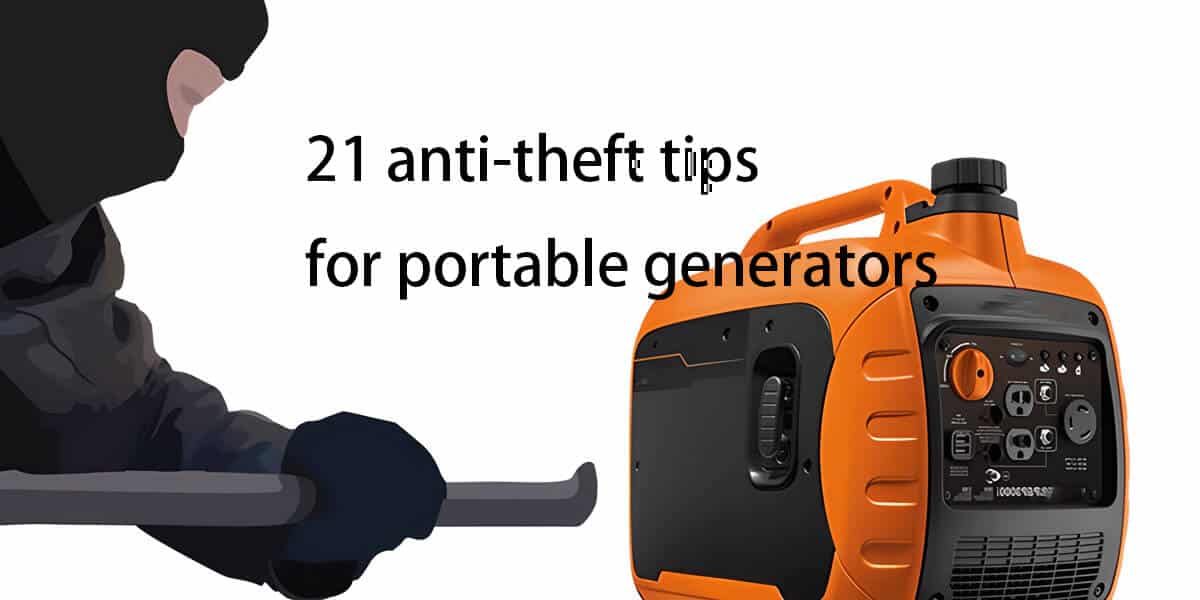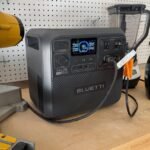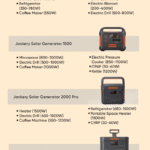Disclosure: This post contains affiliate links and I will be compensated if you make a purchase after clicking through my links. Learn More
Securing a portable generator is crucial for safety and efficiency. It prevents theft and ensures proper functioning.
Portable generators are handy, but they require careful handling. If you own one, you need to know how to secure it properly. This involves safeguarding it from theft, accidents, and ensuring its optimal performance. A secure generator means uninterrupted power during emergencies or outdoor activities.
This blog will guide you through practical steps to keep your generator safe and secure. From choosing the right location to using locks and alarms, we will cover essential tips to protect your investment. Stay tuned to learn how to secure your portable generator effectively and ensure it serves you well.
Choosing The Right Generator
Choosing the right portable generator is crucial for safety and efficiency. The best generator meets your power needs and fits your fuel preferences. Let’s explore how to make this important decision.
Assessing Power Needs
First, determine the power you need. List the appliances and devices you plan to power. Check their wattage requirements. Add up the total wattage. This gives you an idea of the generator size you need.
Consider surge wattage. Some devices need extra power to start. Refrigerators and air conditioners are examples. Ensure your generator can handle these surges.
Considering Fuel Types
Generators use different fuel types. Common options include gasoline, propane, and diesel. Each has pros and cons. Gasoline is easy to find but has a short shelf life. Propane is cleaner and stores longer but needs special tanks. Diesel is efficient and lasts long but is often noisy.
Think about fuel availability in your area. Consider storage and maintenance as well. Choose a fuel type that best fits your situation.

Credit: china-bison.com
Proper Placement
Placing your portable generator correctly is vital. It ensures safety and efficient operation. This section will guide you on how to place your generator properly.
Safe Distance From Structures
A portable generator should be kept at a safe distance from buildings. Place it at least 20 feet away from any structure. This prevents the risk of carbon monoxide entering your home.
Ensure the exhaust is directed away from windows and doors. Never place the generator inside or near enclosed spaces.
Avoiding Wet Conditions
Generators must be kept dry. Do not place them in wet areas. Rain or snow can damage the generator and increase the risk of electrocution.
Use a canopy or tent to shield it from water. Never touch the generator with wet hands.
Regular Maintenance
Regular maintenance of your portable generator is crucial. It ensures that your generator remains reliable and safe to use. A well-maintained generator will not only last longer but also perform better when you need it most.
Checking Oil Levels
One of the most important aspects of maintaining your generator is checking the oil levels. It’s a simple task but can prevent significant issues down the road. Just like your car, a generator needs the right amount of oil to function properly.
Make it a habit to check the oil level before each use. Use the dipstick to ensure the oil is within the safe range. If it’s low, add the recommended oil type specified in your generator’s manual. Overfilling can be just as harmful as running low, so be precise.
I remember one time when my generator wouldn’t start during a power outage. It turned out I had neglected to check the oil levels. Don’t make the same mistake; regular checks can save you from unexpected failures.
Inspecting For Damage
Another critical maintenance task is inspecting your generator for damage. Look for any visible signs of wear and tear. This includes checking the fuel lines, spark plugs, and the generator’s exterior.
Fuel lines should be flexible and free of cracks. Spark plugs should be clean and not fouled. The exterior should be free of dents or damage that could affect its operation. If you notice any issues, address them immediately.
Think of it like giving your generator a routine check-up. Just as you wouldn’t ignore a warning light in your car, don’t ignore the signs that your generator needs attention. Regular inspections can prevent minor issues from becoming major problems.
When was the last time you thoroughly inspected your generator? Taking a few minutes to do so now can save you a lot of trouble later.
Fuel Storage And Handling
Proper fuel storage and handling are crucial for the safe operation of a portable generator. Keeping fuel in the right containers and following safe refueling practices can prevent accidents. This guide will help you understand the best methods for managing fuel.
Using Approved Containers
Always use containers approved for fuel storage. These containers are designed to handle the fuel’s chemical properties. They prevent leaks and reduce the risk of fire. Approved containers are usually made of metal or plastic. They have safety features like child-proof caps. Look for labels that confirm they meet safety standards.
Safe Refueling Practices
Turn off the generator before refueling. This reduces the risk of fire. Allow the generator to cool down. Hot surfaces can ignite fuel vapors. Use a funnel to avoid spills. Spilled fuel can cause fires and environmental damage. Store fuel in a well-ventilated area. This prevents the buildup of dangerous fumes.
Electrical Safety
Ensuring electrical safety is crucial when using a portable generator. Accidents can happen easily. Following safety guidelines can prevent electrical hazards. Let’s explore key practices to keep you safe.
Using Ground Fault Circuit Interrupters
Ground Fault Circuit Interrupters (GFCIs) are essential for safety. GFCIs can detect electrical faults. They shut off power quickly. This prevents electric shocks. Install GFCIs on all generator outlets. Ensure they work properly before use.
Avoiding Overloading
Overloading a generator can be dangerous. It can cause overheating. This leads to fires or equipment damage. Know your generator’s wattage capacity. Calculate the total wattage of your devices. Never exceed the generator’s limit. Use only essential appliances. Spread the load evenly.
Carbon Monoxide Precautions
Portable generators are handy during power outages. Yet, they can pose a danger if not used correctly. Carbon monoxide (CO) is a colorless, odorless gas that can be deadly. Taking precautions can save lives.
Installing Co Detectors
Place CO detectors near bedrooms and living areas. These devices alert you if CO levels rise. Test detectors monthly to ensure they work. Replace batteries regularly for continuous protection.
Ventilation Tips
Always run generators outdoors. Keep them at least 20 feet from windows and doors. This prevents CO from entering your home. Never use a generator in a garage, even with doors open.
Avoid using a generator on a porch or near vents. Proper airflow is crucial. Position the exhaust away from living spaces. Following these tips helps keep your home safe.
Emergency Preparedness
Portable generators are lifesavers during power outages. They keep essential appliances running. But, securing a generator is crucial for safety and efficiency. Emergency preparedness ensures you are ready for any situation. It helps you use your generator effectively and safely.
Creating An Emergency Kit
An emergency kit is essential for generator use. Start with fuel. Keep enough fuel for several days. Store it safely away from your home. Include extra oil for the generator. Routine checks are easier with all supplies handy.
Next, gather extension cords. Ensure they are heavy-duty and long enough. They should reach the appliances you need to power. Add a flashlight to your kit. It helps when setting up the generator in the dark.
Don’t forget a fire extinguisher. Generators can overheat. Be ready to handle small fires. Finally, keep a copy of the generator’s manual. It provides quick help during emergencies.
Establishing A Backup Plan
A backup plan is vital. Identify critical appliances. Know what needs power first. This includes your fridge, medical devices, and lighting.
Next, decide on a safe location for the generator. It should be outside, away from windows and doors. This prevents carbon monoxide buildup.
Test your generator regularly. A monthly check ensures it works when needed. Run it for a few minutes. This keeps the engine in good condition.
Train your family members. Everyone should know how to start and stop the generator. Share the plan with them. This ensures they act confidently during an outage.

Credit: www.youtube.com
Security Measures
Security measures are essential for protecting your portable generator. Theft and damage can happen if not secured properly. The following tips will help keep your generator safe.
Using Locks And Chains
Locks and chains are effective tools for securing your generator. Use heavy-duty locks that are hard to break. Wrap chains around the generator and attach it to a solid structure. Ensure the chain is thick and resistant to cutting tools.
Avoid using thin cables or cheap padlocks. Thieves can easily cut through them. Opt for high-quality materials. This adds extra protection against theft.
Choosing Secure Locations
The location of your generator is crucial for its security. Place it in a well-lit area. Thieves are less likely to target spots that are visible. Avoid isolated or hidden areas.
Consider indoor storage if possible. A garage or shed can provide additional security. If you must store it outside, use a fenced area. This adds another layer of protection.
Always keep the generator out of sight from the street. This reduces temptation for thieves. The more hidden it is, the safer it will be.
Frequently Asked Questions
How To Keep Your Portable Generator From Being Stolen?
Secure your generator with a heavy-duty lock and chain. Store it in a locked, well-lit area. Use a generator cage. Install a GPS tracker. Mark it with identifiable details.
How To Anchor A Generator?
Secure the generator on a concrete pad using anchor bolts. Ensure the bolts match the generator’s mounting holes.
How Do You Secure A Generator To The Ground?
Secure a generator by placing it on a concrete pad. Use anchor bolts to fasten it. Ensure bolts are tight. This prevents movement and provides stability.
How Do You Tie A Portable Generator To Your House?
To tie a portable generator to your house, install a transfer switch. Connect the generator to the switch using a generator cord.
Final Words
Securing a portable generator is crucial for safety and peace of mind. Start by choosing a reliable model with good reviews. Make sure to follow manufacturer guidelines for installation and use. Regularly inspect the generator for wear and tear. Store it in a secure location, away from harsh weather.
Use locks or chains to prevent theft. Proper maintenance extends the life of your generator. With these steps, you can ensure your generator remains safe and functional. Protect your investment and enjoy uninterrupted power.








